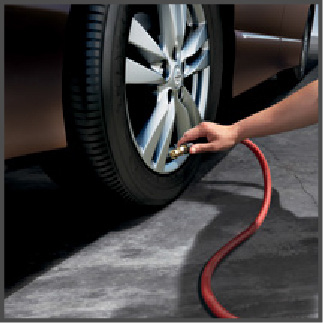
Quick service during peak hours can be a very busy time of day. The workload increases…fluids are changed…tires rotated, and Tire Pressure Monitoring System (TPMS) sensors registered. After rotating or replacing the NV’s wheels the tire pressures must be adjusted, since front and rear pressures are different on the NV (NV1500/2500/3500: front 50 psi and rear 80 psi and transmitter ID registration is required). The NV200 tire pressures are (front 45 psi and rear 47 psi). The NV200 does not require the TPMS sensors to be registered after a rotation. The ID registration can either be performed with the Transmitter Activation Tool J-45295-A (new model), the J-45295 (old model), the Signal Tech II tool (J-50190) and CONSULT III plus (C-III plus), or manually. The Signal Tech II not only is used for ID registration, but some of its other functions include displaying the tire pressures reported by the TPMS transmitters and reading the TPMS DTCs when needed. These additional features of the Signal Tech II can be very useful when diagnosing the TPMS system during the dealership’s peak service hours when the C-III plus is not available. Sometimes the very tools you need to perform a TPMS registration are not available right after a tire rotation was performed. So, if you encounter a customer that just cannot wait; TPMS manual registration may be the way to go since the TPM sensors need to be registered and the tire pressures adjusted after the rotation. NV TPMS registration methods in order of preference are:

1. C-III plus with the Transmitter Activation Tool J-45295-A (new model) or J-45295 (old model)
2. C-III plus with the Signal Tech II
- Activate Sensor Mode enables the Signal Tech II to function similarly to the Activation Tool mentioned above
- With Signal Tech II running the latest software.
3. Manual registration via the Combination Meter and setting individual tire pressures
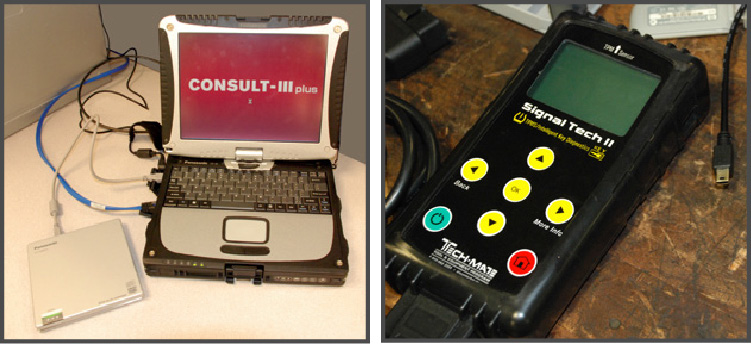
With Signal TECH II and CONSULT
If the Signal Tech II Tool and CONSULT are to be used to register the transmitters, first adjust the NV’s tire pressures to 50 psi on the front tires and 80 psi on the rear tires for NV1500/2500/3500, and 45 psi on the front tires and 47 psi on the rear tires for the NV200. Then, connect the C-III plus, VI to the vehicle and turn the ignition switch and C-III plus ON. Navigate the C-III plus to Air Pressure Monitor → “WORK SUPPORT” → “ID REGIST”, then select Start and OK.
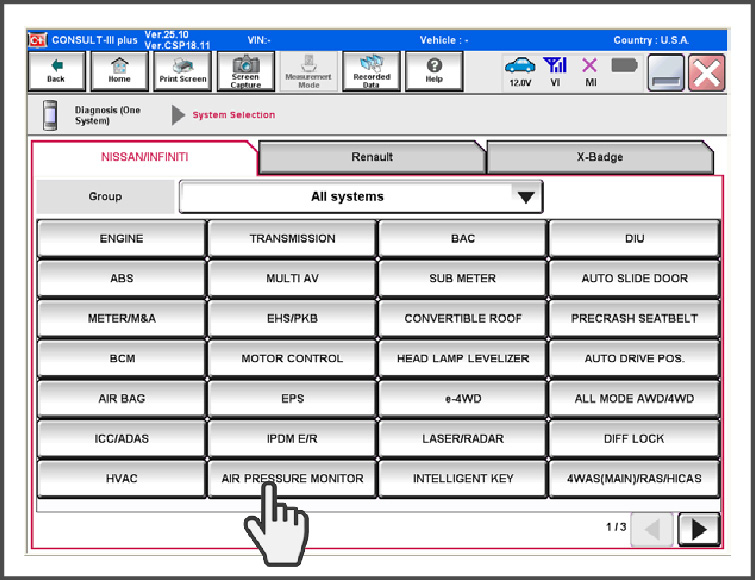
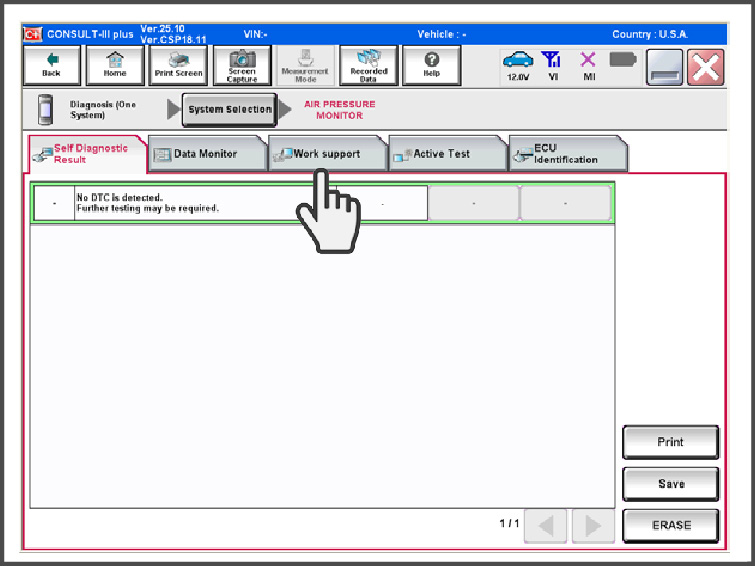
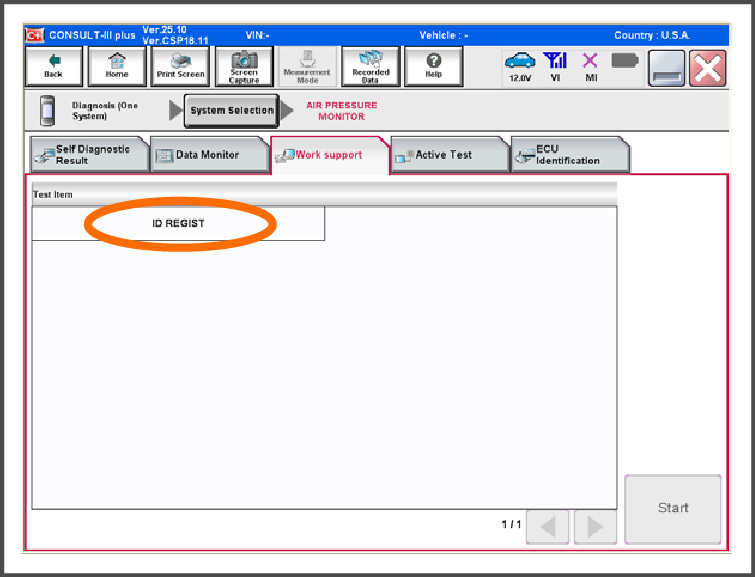
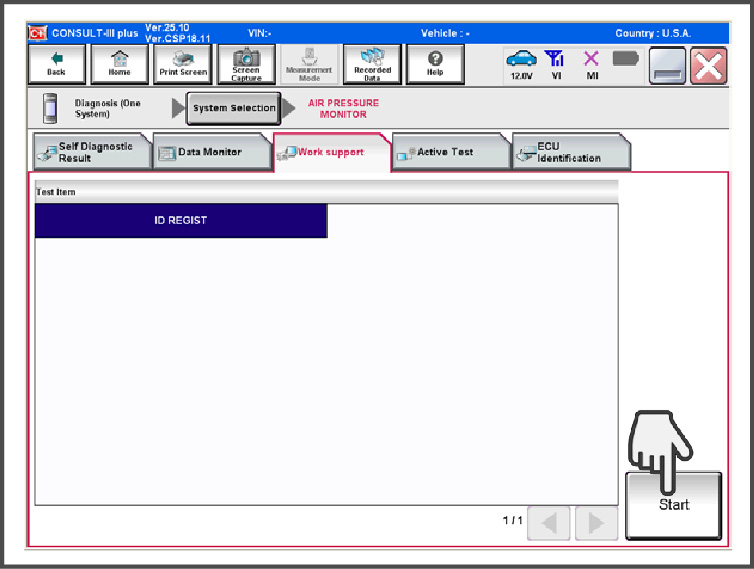
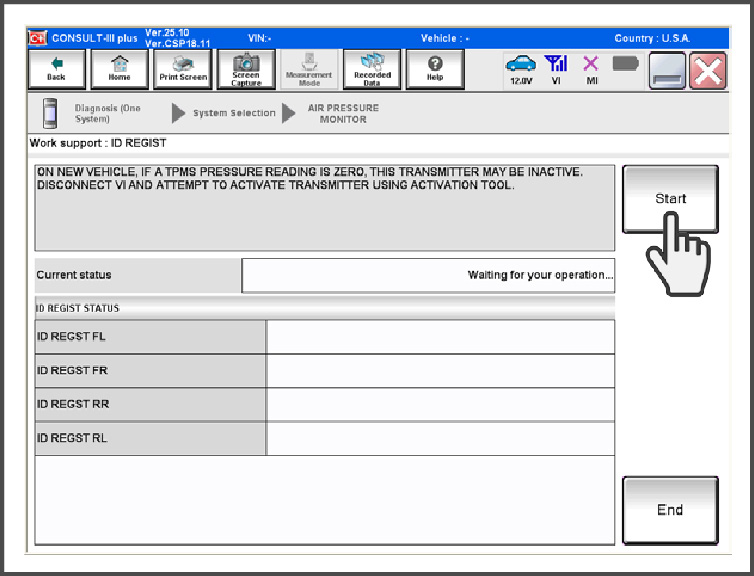
All ID registrations are now erased and are indicated in ‘red’ in WORK SUPPORT.
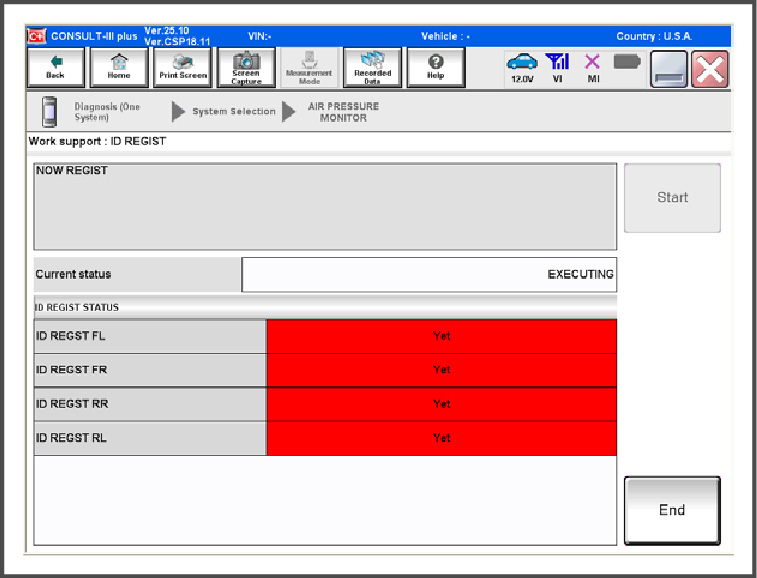
After the C-III plus is ready, select the vehicle from the set up menu on the Signal Tech II. Now, start by pressing the Signal Tech II against the side of the left front tire as close to the transmitter as possible. Select OK. While the Signal Tech II is searching for the TPMS signal, a progress bar will appear on its screen. The Signal Tech II may need to be moved around to locate the TPMS signal. When the Signal Tech II establishes communication with the TPMS sensor, a tone will sound continuously until that sensor has completed its registration (approximately 5 seconds). Continue to hold the Signal Tech II steady until the tone stops, and then repeat on the next wheel.
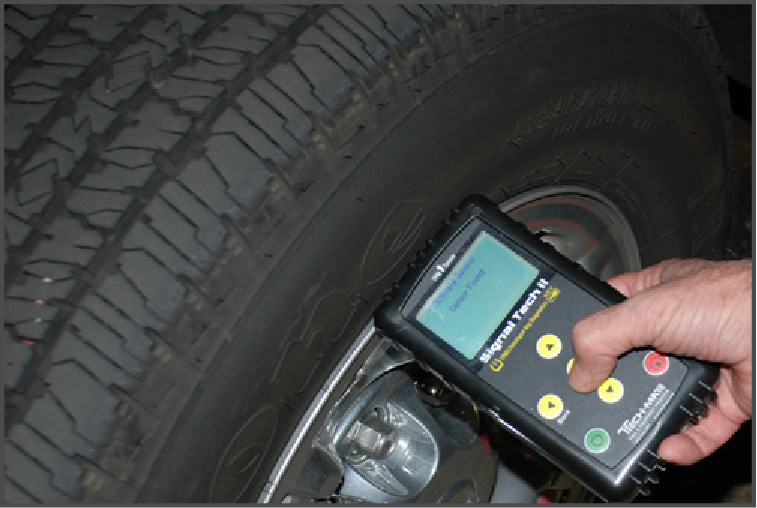
When performing the ID registration procedure, always start at the left front wheel first. Then repeat the procedure on the right front wheel, right rear wheel and then the left rear wheel (clockwise). After all of the transmitter IDs have been registered with the Signal Tech II, confirm that the C-III plus displays ‘Status Complete’. If any of the IDs are still highlighted ‘red’, repeat the registration procedure.
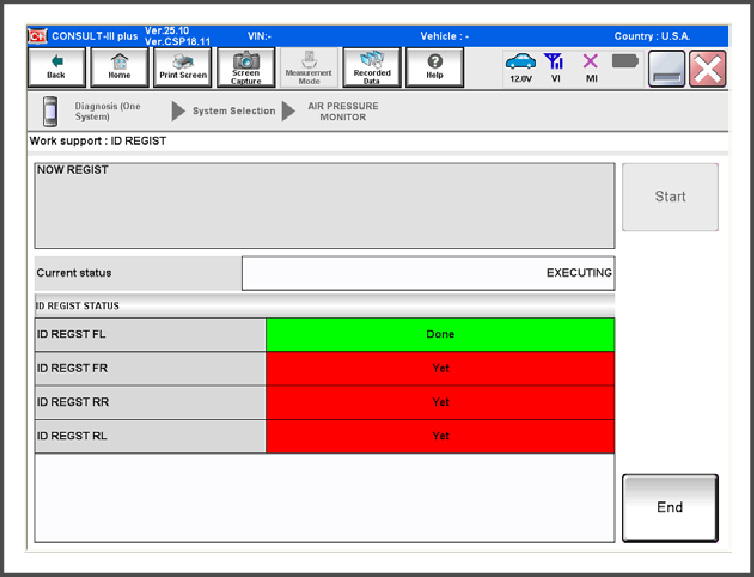
When the registration process is complete, verify COMPLETE REGIST displays, and then press END on C-III plus. This will conclude transmitter ID registration.
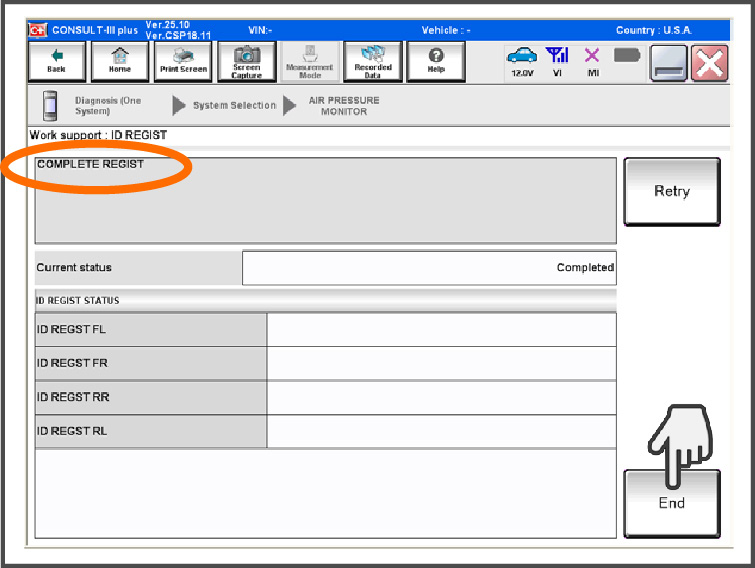
Without Signal TECH II and CONSULT (NV1500/2500/3500 only)
As quick service becomes more in demand, more customers are waiting for their vehicles to be serviced. Shops that have high workloads during their peak hours may not have the time to wait for the CONSULT PC to become available after rotating the tires on the NV1500/2500/3500. In these circumstances the TPMS registration can be performed without the need of the Signal TECH II and C-III plus. After rotating the tires and before adjusting the air pressures, the TPMS can be placed into a relearn mode for 30 minutes and the ID registration performed through the NV’s Combination Meter. To place the TPMS into relearn mode, the air pressure on all four tires must be lowered one at a time, and each tire’s pressure must be lowered by more than 10 psi (34.5 kPa) in a continuous deflation within 30 seconds. After all four tires have been deflated, adjust the tire pressures to: left front – 25psi, right front – 40psi, right rear – 60psi, and left rear – 80psi. This will allow the TPMS to identify where each wheel is now located. When the tire pressures have been adjusted, the ID registration procedure is started by using the INFO knob (left knob in display face) in the Combination Meter as follows: Rotate the knob clockwise until SETTINGS appears. Then select TPMS MENU → RELEARN → CONFIRM → LEARNING.
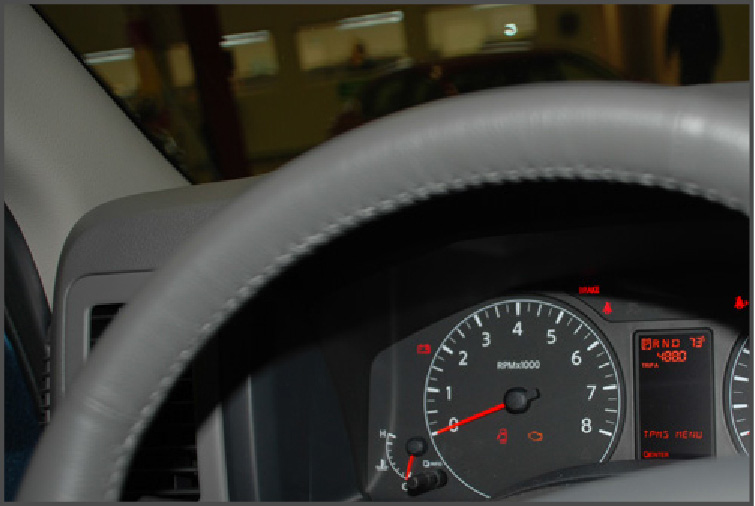
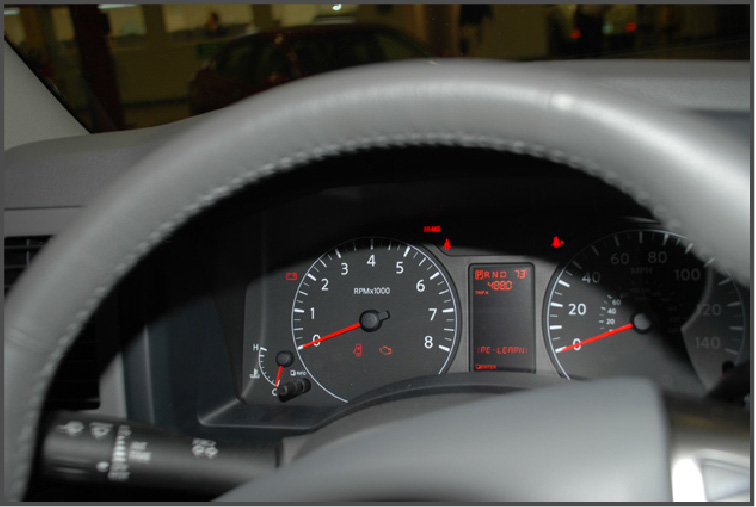
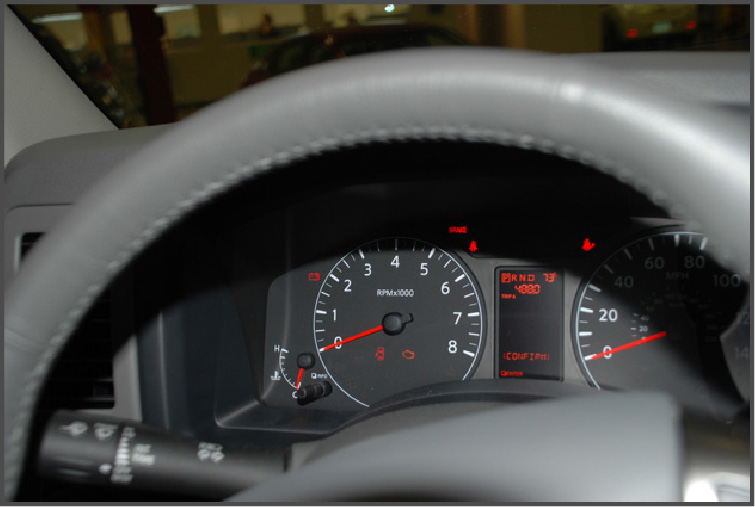
NOTE: The relearn procedure can be cancelled by placing the ignition switch in the OFF position or by driving the vehicle over 3 MPH (5 km/h).
While the TPMS is relearning the tire positions, the TPMS warning lamp will flash continuously. After the TPMS system has relearned each of the new tire positions, the TPMS warning lamp illuminates for 3 seconds, the message “RELEARN OK” displays in the combination meter, a chime sounds 3 times and the horn chirps once. Once the onboard ID registration is complete, adjust the NV’s tire pressures to 50 psi on the front tires and 80 psi on the rear tires.
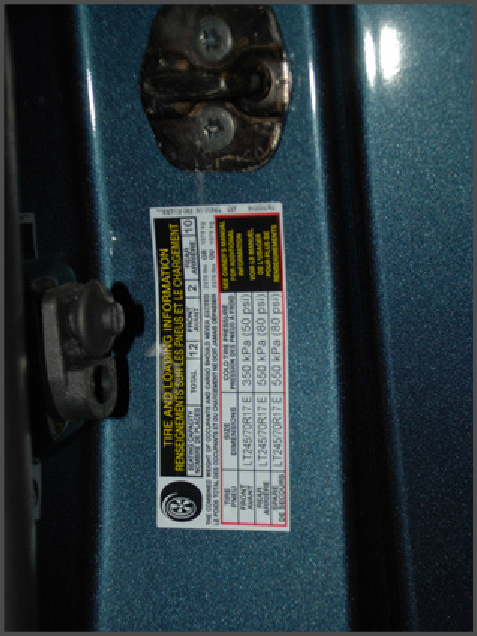
After TPMS Registration is Complete (NV1500/2500/3500 only)
After the TPMS registration is complete, the TPMS warning lamp will turn off. If the TPMS warning lamp does not turn off, recheck the tire pressures first and confirm that they are at 50 psi on the front tires and 80 psi on the rear tires for NV1500/2500/3500. If the TPMS light remains on after the tire pressures have been verified, the ID registration may need to be repeated. Before repeating the registration procedure, confirm that any devices which might emit electronic interference are turned OFF (a cell phone may not be in use, but it is still intermittently transmitting) before starting the relearn procedure. Electronic interference may prevent the system from learning the new tire positions. If necessary, move the vehicle to another location, then perform the complete relearn procedure to reset the tire positions. If the vehicle is not recognizing the new tire pressure levels and has not been moved yet, move the vehicle forward 40 inches (1 meter). Place the ignition switch in the OFF position, then to the ON position and perform the registration procedure from the beginning. See the Electronic Service Manual under SUSPENSION → Road Wheels & Tires for further detailed information.
